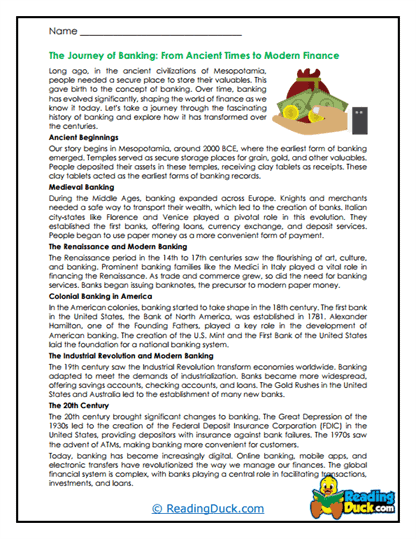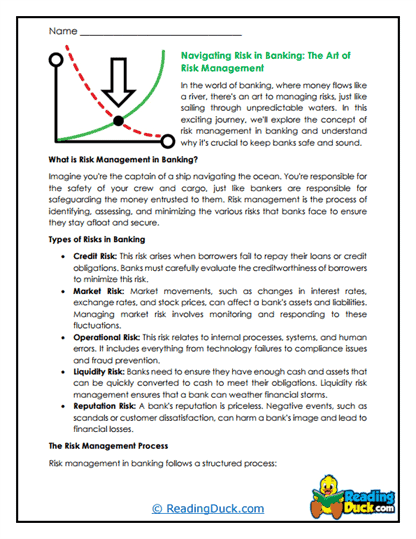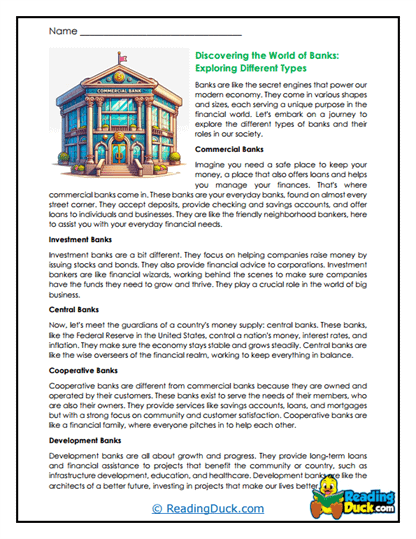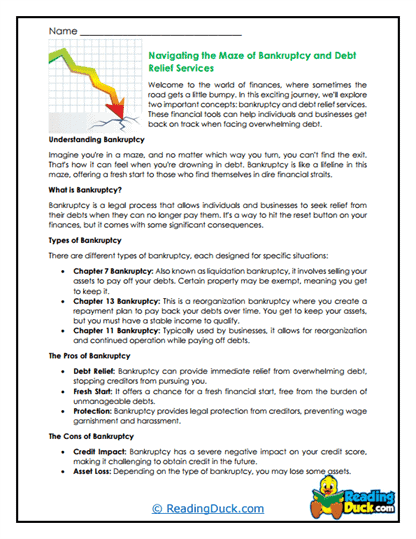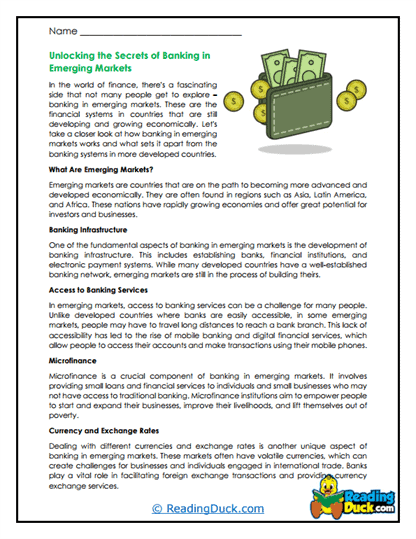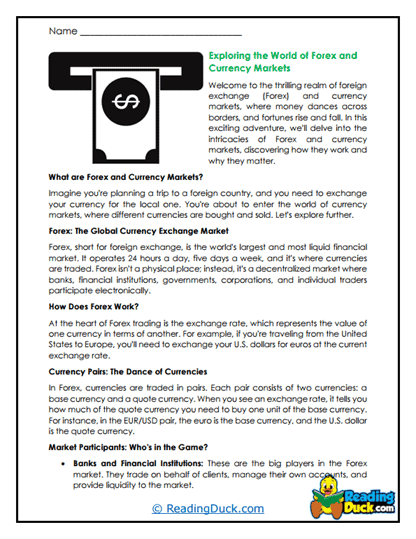Banking Worksheets
About Our Banking Worksheets
Our Banking Worksheets provide students with an in-depth understanding of the banking system and its crucial role in the economy. These worksheets are part of the Economics category, which covers a broad range of topics such as Budgeting, Companies, Economic Systems, Financial Literacy, Real Estate, Stock Market, Supply and Demand, and Taxes. This particular collection focuses on the fundamental concepts of banking, offering students a comprehensive overview of how banks operate, their functions, and their impact on both personal finance and the broader economy.
This topic contains several worksheet sets, each focusing on a specific aspect of banking. Each worksheet set includes:
- Multiple Choice Questions: These questions assess students' comprehension of the reading passages, focusing on key details about banking operations, types of accounts, interest rates, and the role of banks in the economy.
- Short Answer Questions: Students provide concise responses, summarizing essential information, analyzing the functions of banks, and reflecting on how banking affects individual financial decisions and economic stability.
- Open-Ended Questions: These questions encourage students to think critically and express their personal interpretations, opinions, and preferences related to the banking topics they have read about, deepening their connection to the material.
These worksheets help students demonstrate their understanding of banking while fostering meaningful engagement with the subject. An answer key is provided for each question sheet, making it easy for teachers and parents to evaluate student progress. All worksheets are available as PDF files, which can be easily viewed electronically, downloaded, and printed.
Understanding Banking: The Backbone of the Economy
Banking is a cornerstone of the modern economy, playing a pivotal role in both individual financial management and the broader economic system. At its core, banking involves the management of money through various services, including savings and checking accounts, loans, and investments. Banks serve as intermediaries between savers and borrowers, facilitating the flow of money that drives economic activity. By studying banking, students gain a fundamental understanding of how financial institutions operate, the importance of saving and investing, and the mechanisms that support economic growth.
When studying banking, students encounter a variety of key concepts and areas of interest:
- The Functions of Banks: Banks perform several essential functions that contribute to the stability and efficiency of the economy. Students explore how banks accept deposits, provide loans, and offer payment services. They learn about the different types of banks, including commercial banks, investment banks, and credit unions, and how each type serves a specific role in the financial system. Understanding these functions helps students appreciate how banks contribute to economic stability and growth by managing risk, allocating capital, and facilitating transactions.
- Types of Bank Accounts: One of the first steps in personal finance is choosing the right type of bank account. Students learn about the different types of accounts offered by banks, such as savings accounts, checking accounts, and certificates of deposit (CDs). They explore the features and benefits of each account type, including interest rates, fees, and accessibility. This knowledge empowers students to make informed decisions about where to keep their money, how to manage their funds, and how to achieve their financial goals.
- Interest Rates and Loans: Interest rates are a critical component of banking, affecting everything from savings to borrowing. Students delve into how interest rates work, the factors that influence them, and their impact on personal and business finances. They explore the concept of loans, including the types of loans available (e.g., personal loans, mortgages, student loans) and the role of creditworthiness in securing a loan. By understanding interest rates and loans, students gain insight into how borrowing can help achieve financial goals while also recognizing the importance of managing debt responsibly.
- The Role of Central Banks: Central banks, such as the Federal Reserve in the United States, play a vital role in the economy by regulating the money supply, setting interest rates, and ensuring the stability of the financial system. Students learn about the functions of central banks, including monetary policy, financial regulation, and crisis management. They explore how central banks influence economic activity by controlling inflation, stabilizing currency, and responding to financial crises. This understanding of central banking helps students grasp the broader economic context in which commercial banks operate.
- The Evolution of Banking: Banking has a long history that reflects the development of economies and societies. Students trace the evolution of banking from ancient times, when moneylenders and merchants facilitated trade, to the modern era of digital banking and global financial markets. They explore how innovations in banking, such as the introduction of ATMs, online banking, and mobile payment systems, have transformed the way people manage their money. This historical perspective helps students appreciate the dynamic nature of banking and its ongoing adaptation to technological and economic changes.
- The Impact of Banking on the Economy: Banks are integral to the functioning of the economy, influencing everything from individual financial decisions to global economic trends. Students examine how banks contribute to economic growth by providing capital for businesses, facilitating trade, and supporting consumer spending. They also explore the role of banks in economic crises, such as the 2008 financial crisis, and how government regulations and policies aim to ensure the stability and security of the banking system. This study of banking's impact on the economy helps students understand the interconnectedness of financial institutions and the broader economic environment.
Through these topics, students gain a comprehensive understanding of banking as both a personal finance tool and a key component of the global economy. They learn to appreciate the complexity of banking operations and the importance of making informed financial decisions.
Real-World Applications
Understanding banking is essential for students as they prepare to navigate the financial world as adults. Proficiency in this topic equips students with the knowledge and skills they need to manage their personal finances, make informed decisions about saving and borrowing, and understand the broader economic forces that impact their lives. By learning about banking early on, students can develop financial literacy, which is critical for achieving financial independence, avoiding debt, and building wealth.
In the real world, the ability to understand and use banking services is a fundamental life skill. Whether it's choosing the right bank account, applying for a loan, or managing credit, students who are well-versed in banking are better prepared to handle the financial responsibilities of adulthood. Additionally, an understanding of banking helps students make sense of economic news, grasp the significance of interest rate changes, and appreciate the role of financial institutions in their communities.
Moreover, a solid foundation in banking can lead to career opportunities in finance, economics, and business. Students who are interested in pursuing careers in these fields will find that a deep understanding of banking is crucial for success. Whether they aspire to be financial analysts, economists, or business leaders, students who master the concepts of banking will have a significant advantage in the job market.
Using These Worksheets In A Curriculum
These banking worksheets can be seamlessly integrated into various subjects and classes, particularly in economics, business, and personal finance courses. For middle school students, these worksheets provide an introduction to the basics of banking, helping them understand the importance of saving and managing money. For high school students, the worksheets can be used in more advanced courses to explore topics such as interest rates, loans, and the role of central banks in greater depth. Additionally, these worksheets can be incorporated into real-world applications, such as budgeting exercises or mock banking scenarios, to give students hands-on experience with banking concepts.
These worksheets not only reinforce key economic principles but also help students develop critical thinking and problem-solving skills. By analyzing real-world banking scenarios and answering questions that require them to apply their knowledge, students build a strong foundation in financial literacy that will serve them well throughout their lives.
Overall, the Banking Worksheets provide a comprehensive and engaging way for students to explore the world of banking, gain a deeper understanding of its significance in the economy, and develop the skills they need to manage their finances effectively.

